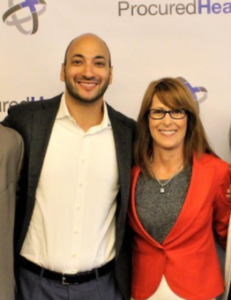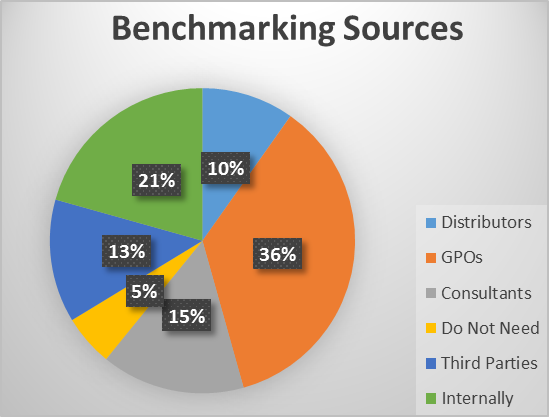Hani Elias, JD, MPH, CEO and Co-Founder of Procured Health
Gina Thomas, RN, MBA, Procured Health Chief Development Officer
 Hani Elias is the CEO and co-founder of Procured Health. Prior to starting Procured, he was a consultant in McKinsey & Company's healthcare practice and a founding fellow of the firm's healthcare economics think tank, the Center for US Health System Reform. He has spoken on clinical spend management at many industry conferences, including AHRMM and the MedAssets healthcare business summit. He is a three-time graduate of Harvard University, earning his bachelors degree, masters in public health, and law degree from the school. Visit Procured Health at www.procuredhealth.com/knowledge.
Hani Elias is the CEO and co-founder of Procured Health. Prior to starting Procured, he was a consultant in McKinsey & Company's healthcare practice and a founding fellow of the firm's healthcare economics think tank, the Center for US Health System Reform. He has spoken on clinical spend management at many industry conferences, including AHRMM and the MedAssets healthcare business summit. He is a three-time graduate of Harvard University, earning his bachelors degree, masters in public health, and law degree from the school. Visit Procured Health at www.procuredhealth.com/knowledge.
Gina Thomas, RN, MBA – Procured Health Chief Development Officer, Gina spearheads commercial strategies and helps guide product vision. With over 35 years of healthcare experience, starting as an emergency room nurse and later becoming a nursing executive, she brings a wealth of knowledge to the company, including strong expertise in preparing for new payment models, aligning clinicians, service line best practices, and executive-level approaches to resolving fragmentation in healthcare. She is passionate about patient advocacy. On a personal note, she has been married 32 years to her #1; has 2 daughters who she adores; and she says they have even found great guys who they married!
(VAMag) Could you tell us a bit about your background and how you got into value analysis in healthcare?
Hani: I came to value analysis without really knowing much about the discipline. I was previously a management consultant at McKinsey & Company, and while there, I worked with a client that struggled to gain market awareness in the US for a less expensive, clinically equivalent medical product.
That experience led me to critically examine how hospitals and clinicians made decisions in various parts of the world. It was striking to me that, in the US, clinical preferences were often the result of a sophisticated sales team rather than a thorough analysis of the product. That’s how I was introduced to value analysis and variation reduction. I saw a huge opportunity to improve our healthcare system.
Gina: In the 1990s, I joined what was then Baxter Healthcare as a consultant, based on my experience in emergency nursing and nursing Administration. I initially focused on driving down costs per procedure, primarily in the OR. Over a span of the next 10+ years, I served both as a consultant and back in the provider space either consulting on or setting up value analysis processes and teams.
(VAMag) As a leader in Evidence-Based Value Analysis, why do you think it is important for hospitals to integrate an evidence-based approach to their value analysis programs?
Hani: Without evidence, hospitals and clinicians are left making decisions based on what they have available: Marketing materials and personal experience with the product.
Unfortunately, marketing materials are inherently biased and incomplete and personal experience is inherently limited. Evidence allows for much more confident decision making. It shouldn’t be the only information source, but it is a key one that has been missing from most product use and value analysis decisions.
Gina: As an avid reader, I believe that knowledge is the key to improving our ability to make decisions. Healthcare is no different, and in this case, knowledge can save lives. Unfortunately, I’ve had experiences both professionally and personally where evidence wasn’t fully leveraged and patients’ lives were jeopardized. So to say I’m passionate about this is an understatement.
Providing clinicians with facts optimizes their ability to make truly informed decisions about the treatment of their patients. An evidenced-based approach transcends value analysis programs. Evidenced-based decisions must span all levels and service lines within an organization. It takes an army to sift through all the available information and pull out the facts required to provide great patient care.
At Procured Health, we’ve done our own investigations and have found that clinicians would have to read approximately five hours a day just to keep up with all of the new and increasingly complex information out there. There’s a great video about all the information inundating the human brain today—it’s no wonder that it’s such a challenge to integrate an evidenced-based approach with so much information.
 (VAMag) The Surgical/Perioperative area of the healthcare supply/value chain has been traditionally known as the “Last Bastion of Supply Chain Savings.” What have we been missing all these years that we can now address today?
(VAMag) The Surgical/Perioperative area of the healthcare supply/value chain has been traditionally known as the “Last Bastion of Supply Chain Savings.” What have we been missing all these years that we can now address today?
Hani: Two macro-level factors are making it possible to address cost in what have historically been “third-rail” categories. First, there is a much greater appreciation across all stakeholders for the need to be better financial stewards for the patient. Sensitivity towards healthcare cost inflation has increased and we’re seeing a desire to deliver value, not just quality. Second, significant technological advances are enabling health systems and clinicians to make better decisions. These shifts are affecting multiple areas in the hospital, and supply chain has benefited tremendously.
Gina: Utilization should be addressed at a deeper level using evidence, trends, and market dynamics. There are some great articles out there showing that money drives utilization. I don’t embrace the notion that clinicians knowingly perform more procedures when they are paid at a higher rate. However, we do have solid evidence of over-utilization, over-prescribing, and over-diagnosis which is due to a combination of the no-patience, “just-give-me-a-pill-for-that” society we now live in along with certain payment and incentives structures. It’s time to take a hard look at the utilization issues, but that requires all of us to be diligent or continue to face the consequences.
(VAMag) Over the past few years, you have published articles and blog posts regarding doing away with the value analysis committee model in healthcare. Could you explain why healthcare organizations should consider this audacious approach?
Hani: Too often, I see value analysis teams focused on managing product introductions. They have processes and governance committees in place to conduct due diligence and facilitate the introduction of new products. These groups could have a much larger return on investment if they also tackled existing spend, including eliminating unnecessary variation and ensuring appropriate usage of products.
Because these strategies require clinical engagement, physician time quickly becomes the limiting factor. As the number of committees increases, it becomes more and more difficult to find physicians willing to contribute their time. Moreover, several other operational functions within the hospital also require physician time. By looking at all of these topics and issues holistically, physicians can make more informed tradeoffs. For example, they might recognize that a reduction in supply costs can be used to support investment in OR efficiency.
Gina: Value analysis as a stand-alone governance process is failing, and many organizations have seen this. It must be embedded within an organization’s clinical care governance as a patient-centered multidisciplinary approach. Unfortunately, many value analysis leaders have been inundated with contracting and sourcing projects rather than having the opportunity to drive true value from a clinical and evidenced-based perspective.
In addition, value analysis committees are trying to ‘pull’ clinicians to their committees when it would be more beneficial for value analysis leaders to be invited to a clinician’s conversations about care decisions. Even with the best intentions, starting a conversation with a clinician by talking about contracting and/or cost doesn’t yield effective results. However, clinicians are all concerned with high-quality care; they sincerely want to provide evidenced-based medicine and most truly believe they are doing so. Unfortunately, there’s no practical way for them to keep up with evidence without the intense reading I mentioned earlier.
Our own research shows that clinicians don’t become dissatisfied with healthcare organizations because of the treatment options available to their patients, they become dissatisfied when they can’t efficiently provide that treatment. If hospitals could provide clinicians with evidenced-based insights that enhance the time and processes required for patient care, I strongly believe it would lead to better decisions for patients from both a quality and financial perspective. And that’s not even talking about the hospital’s cost burden. This is what it would take to conquer waste in healthcare. To paraphrase an expression from my nursing days: “The right drug at the right dose would be used on the right patient at the right time for the right care.”
 (VAMag) In a recent video released on Linkedin.com, you have shared a collaborative roundtable session with an emphasis on Physician engagement and communications. How can this help value analysis, supply chain, and hospital executives meet their value-based goals?
(VAMag) In a recent video released on Linkedin.com, you have shared a collaborative roundtable session with an emphasis on Physician engagement and communications. How can this help value analysis, supply chain, and hospital executives meet their value-based goals?
Hani: You can’t stamp out unnecessary variation and unwarranted cost without physician engagement. Doctors, as well as nurses, have great ideas, and administrators who harness their input reap significant rewards.
Gina: By taking a patient-centered focus, collaborative roundtables such as ours allow for people from different organizations to talk through their challenges in a safe environment. No matter if it’s a clinician or a hospital leader, they not only share strategies but discuss how they might facilitate success at their own respective organizations.
(VAMag) Where do you see the healthcare value analysis world going in one, two, or even five years from now and how should hospitals, systems, and IDNs be positioning themselves to maximize value in the era of value-based purchasing?
Hani: I can see value analysis evolving in two ways. I can see a world where value analysis is the source for product information. There is momentum to push sales reps out of the OR, and I can see health systems making investments to ensure they have internal resources who can serve as subject matter experts in specific categories. This will require hiring more value analysis leaders, because having the domain expertise necessary to contribute to physician needs in several areas will be difficult. Value analysis leaders will serve as category managers and be responsible for managing new and existing spend, as well suggesting new products to physicians and nurses that improve value, even if they are costlier.
I can also see a world where value analysis is subsumed within performance improvement and service line optimization efforts. As health systems look at cost per case more holistically, I won’t be surprised if there is an organizational shift to align with a new unit of analysis.
Gina: The greatest value comes from true integration with clinicians at the bedside around the clinical decisions being made. Giving proactive insight into trends that are occurring within patient treatment decisions will drive greater outcomes for patients and the systems that serve them. Think about the possibilities if information could be shared with a physician’s office or in the emergency department for certain diagnoses instead of waiting for an event to happen.
For instance, a patient who has a history of heart disease would be flagged with the latest therapies and applicable evidence, including the trends in efficacy and safety from both a quality and cost perspective. Care coordination rounds with clinicians, pharmacists, service line leaders, and social workers would address the decisions for drugs and devices in the moment of treatment by reviewing the evidence on an iPad or smartphone. We may raise the bar of high-quality care at a more effective cost compared to other countries!





